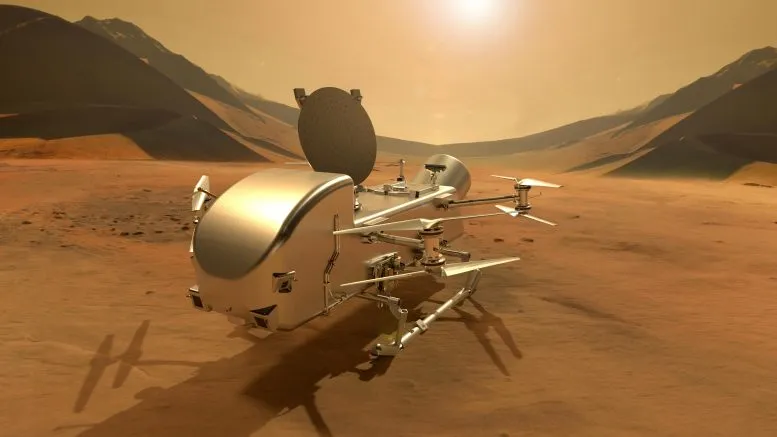NASA’s Mars helicopter mission may have come to an end, but the space agency is already gearing up for its next big adventure – the Dragonfly mission to Saturn’s largest moon, Titan. The historic announcement marks a significant milestone in the development of the eight-rotor aircraft, designed to explore the uncharted territories of Titan’s dense, calm atmosphere and low gravity.
According to NASA, the Dragonfly mission is a spectacular science mission with broad community interest, and the agency is excited to take the next steps towards its completion. As the largest moon of Saturn, Titan is a fascinating world that offers scientists a unique opportunity to study the origins of life on our planet. With its size equivalent to being 50% larger than Earth’s moon, Titan is a prime target for NASA’s planetary exploration program.
The Dragonfly mission is scheduled to launch atop a rocket in 2028 and arrive at Titan in 2034. Once deployed, the rotorcraft will spend most of its time on Titan’s surface conducting science measurements, gathering data that will be beamed back to scientists on Earth. The mission’s primary objective is to search for evidence of prebiotic chemical processes common on Titan and also on the early Earth before life developed.
Titan’s unique environment, with its thick atmosphere and low gravity, makes it an ideal location for airborne exploration. Unlike on Earth, where helicopters would struggle to take off and land due to the dense atmosphere, Titan’s atmosphere is much thinner and allows for rotorcraft like Dragonfly to fly effortlessly. In fact, NASA claims that Dragonfly will cover tens of miles or kilometers in under an hour, farther than any planetary rover has traveled, and travel between dozens of scientifically interesting locations in a search for evidence of life.

NASA goes on Ambitious Dragonfly Mission to Saturn’s Largest Moon
The mission’s science instruments will focus on studying Titan’s atmosphere, surface, and potential habitability. By analyzing the moon’s chemistry, geology, and climate, scientists hope to gain insights into how life may have evolved on Titan and whether the moon’s conditions could have supported life in the past. The mission’s findings will also provide valuable information on the early Earth, as scientists seek to understand the origins of life on our planet.
Dragonfly’s design is impressive, with its eight rotors allowing it to hover low over Titan’s surface and conduct detailed surveys. The rotorcraft’s size is equivalent to a small car, making it an imposing sight on the moon’s surface. Its ability to fly between different locations will enable scientists to gather data from a wide range of environments, from dense forests to rocky outcrops, and from the surface to the atmosphere.
As the mission progressed, NASA will continue to test and refine the Dragonfly design, ensuring that it is capable of withstanding the harsh conditions on Titan. The space agency will also work closely with international partners to integrate the mission’s scientific instruments and ensure that the data collected is of the highest quality.
The Dragonfly mission is a testament to NASA’s commitment to exploring our solar system and seeking answers to some of humanity’s most profound questions. By venturing to the distant world of Titan, scientists hope to unravel the mysteries of the early Earth and the origins of life itself. As the mission prepares for its historic launch in 2028, NASA is poised to make a groundbreaking discovery that will rewrite the textbooks on the history of life on our planet.








































